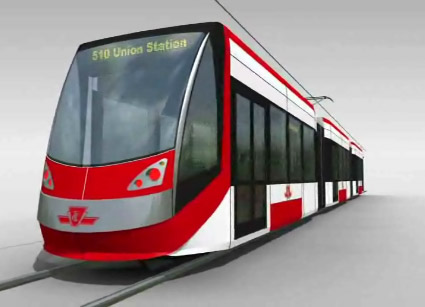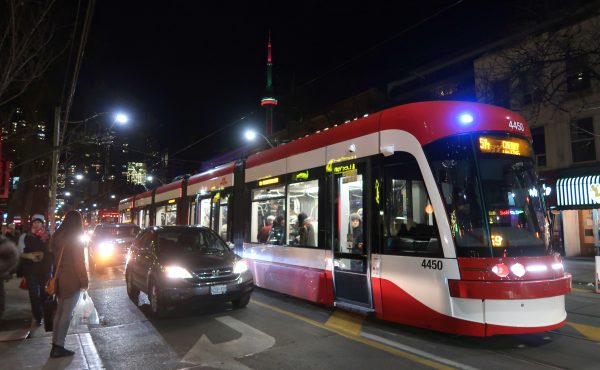
A Siemens rendering from 2007 of a possible new TTC streetcar
This rather interesting tidbit of TTC news just arrived in Spacing’s inbox:
The Toronto Transit Commission today announced that it has cancelled the Request for Proposal process to purchase 204 new low-floor streetcars. The bids it received have been deemed non-compliant. The TTC is now reviewing its options to ensure the current streetcar fleet is replaced starting in 2012 with new, accessible vehicles.
The TTC received two submissions for the $1.25 billion project. TRAM Power Ltd. and Bombardier Transportation submitted bids, but upon review TRAM Power failed to pass step one of the bid review process as it was not commercially compliant. Bombardier Transportation failed on step two — a technical evaluation that required a pass/fail on key criteria related to negotiating the tight turning radii on the TTC’s existing streetcar rail system.
A Fairness Monitor was retained to oversee the procurement process and concurs that the TTC has followed the process as set out in the RFP and also concurs with the cancellation of the RFP.
Under its procurement rules, the TTC may contact any vendor, including those who responded to a Request for Expressions of Interest, a process undertaken before the RFP was issued, and begin discussions to determine what, if any, issues or concerns any of the companies may have with respect to the requirements of this RFP.
The TTC is confident that it can work with a vendor to remain on schedule and meet its needs for new streetcars, including the option to purchase up to an additional 364 streetcars for Transit City. Using the specifications set-out in the original RFP, the TTC will now contact known and proven streetcar manufacturers to identify and discuss the issues that led the companies to a decision either not to bid, or to submit a bid that is not compliant.
This process will take approximately four weeks to complete. The TTC will then make a recommendation to the Commission on next steps.




23 comments
Frustrating, but not a huge surprise. Few other light rail systems operate on the turning radii or track width or mixed traffic of the TTC, so it’s not as easy as when Houston or Minneapolis or Charlotte go shopping for a new LRT vehicle. There was some rationale after all for forming a provincial company just to build TTC streetcars in the 1970s.
Alstom and Siemens make the trams used by Melbourne, the city with a network most comparable to Toronto. Perhaps they can be induced to bid if Bombardier can’t resolve the turning issue.
Actually, this is the best news I’ve heard about this bid process so far. It shows that the TTC is taking the reasons for non-compliant and non-existant bids seriously. It absolutely should take this step in order to resovle the issues in the RFP that led to zero compliant bids. Once the terms of the RFP are refined, or the reasons for not bidding/submitting non compliant bids are understood, we may end up with a more competitive final set of options.
What is the likelyhood that the problem with the turning radius is also related to the 100% low floor requirement? That seems like an enormous engineering hurdle for all kinds of reasons. Anyone have ideas about this?
I’m still not convinced that this will bring Siemens back to the table given their recent economic woes, but maybe someone else…
good luck,Adam Giambrone was on 640 AM trying to explain the screwup.It seems there is no real solution at the moment for the track width turning radius problem that won’t cost the city a fortune.
Maybe the solution is buses.
Let’s just order up some replica PCC cars.
The fact that companies didn’t meet the technical specs called for in the RFP is hardly a screwup on the part of the TTC, George.
“What is the likelyhood that the problem with the turning radius is also related to the 100% low floor requirement?”
100% Low floor is challenging when you don’t have large gradients and tight turns, because of the need to keep wheel and bogie size down in the middle of the car. As we are now seeing, it’s damn near impossible if you have both.
TTC should now look urgently at severing St Clair from the legacy network and making it Line 1 of Transit City so that procurement of double end cars for TC can start there and the legacy cars can be stretched out over a longer period. A St Clair Transit City line could be extended to Eglinton West and continued while the Eglinton West tunnel is built in parallel.
The tightest parts of the network should be rebuilt or bypassed and maybe partially converted to double-end – the railfans won’t like that because the old cars won’t be able to run on those parts but as the guy from San Francisco noted our streetcars are for residents not for tourists.
Jeff – if the answer is buses it means about three buses for every streetcar that would have been purchased in this tender. That’s three times as many drivers at a time when the TTC is hardpressed to hire as it is.
That said, I expect to see Kingston Road replaced with buses now because of insufficient cars, and maybe Lakeshore from Long Branch to Humber too. Hell St Clair-ites have gotten so used to buses over the last few years, what’s a few years more?
No need Rob – our old PCCs are still around. We just need to invade Wisconsin and take them back:
en.wikipedia.org/wiki/Streetcars_in_Kenosha,_Wisconsin
Seriously, who was the dumb-as-rocks nutjob that approved that sell-off?
Buses suck. I’d rather walk.
I hope the TTC has examined the cost/benefit of including all of these extra technical requirements in the RFP, rather than just giving a wish list.
To put it simply, is the incremental cost of each of these modifications (relative to the out of the box model used elsewhere in the world) worth the additional benefit?
For example, per the Globe and Mail today, one of the requirements is that each vehicle be able to “push a disabled streetcar up a hill near Union Station”. Has the TTC considered whether the cost of this additional modification would is worth the additional benefit? Assuming the cost of this modification is $10,000 extra per streetcar – multiplied by the 200 streetcars initially purchased – you are talking about a cost of $2,000,000 for this modification. My guess is that you could also buy a pretty impressive alternate towing vehicle for this price. The TTC should also be considering whether the additional weight this modification could add would mean a significant reduction in energy efficiency or added noise.
While the numbers I am using are just random guesses to illustrate the issue, my concern is someone is making sure that the TTC is actually undertaking this analysis rather than simply reproducing an Engineer’s wish list as an RFP.
To give another example, I hope the TTC would be seriously considering the following questions: how many of our loops are 11 metre radius? What is the additional cost to ensure the new vehicles meet this requirement? Can some of these loops be removed or widened? Can we come up with an alternative approach so that we can encourage more bidders or otherwise reduce the cost of the vehicles?
Are the tightest turning radii with loops, or are they on some street corners? I can’t say for sure, but I suspect the latter.
Given that Melbourne has similar tight-corners with the mixed-traffic parts of their tram network, and have similar grades as we have in Toronto, I am wondering what is the problem with 100% low floor cars when both Siemens and Alstom cars are functional there.
There are two differences in Melbourne. First, the requirement to push or pull another car up a grade is not there, as Melbourne has trucks available for this. There is nothing special about these trucks other than a bumper designed to not inflict damage on a tram when pushed.
The other difference is our use of single-blade switches. These work fine when a pair of wheels and their axles are machined from one solid chunk of steel, as is the case with high-floor cars. The single switch point shifts the whole mass to follow the proper route. When the left and right wheel have their own independent suspension, as is the case with low floor designs, there are a number of forces that must be taken into consideration in the design that may be the bigger issue here. The new Transit City lines will be built with double-blade switches, but it will be quite some time before the legacy system is converted. I would bet the legacy system will be running completely with pantographs for some time before all the switch points are replaced.
Rob, some strange requirements did creep in (i.e. 100% low floor instead of 70% low floor) but your two examples sound legit to me.
My understanding is that the “push a disabled streetcar up a hill near Union Station” requirement is something today’s streetcars can do, and it’s needed in case a streetcar dies while in the tunnel under Bay street. That tunnel isn’t designed for trucks, and (due to exhaust) I’m not sure it could be made truck-safe. So the next streetcar on the line needs to be able to push the disabled streetcar around the loop and up to street level.
And an 11 metre turning radius sounds to me like what you’d find at the intersection of two streets each about 24 metres from building edge to building edge, which I believe is fairly typical downtown.
blarg>don’t attack me for what the TTC specified.They tried to obtain all kinds of new features and then believed that manufacturers could “invent” a new vehicle to meet those specs.The manufacturers compromised the best they could and threw it back at government officials.This would allow the company to keep the tender and have officials “modify” their specifications.It’s a cat and mouse game that Adam Giambrone and council doesn’t seem to understand.In the end the “buck stops with Adam”!However we now pay millions in delays and other costs.And at a time when transit should be a priority it seems the public is back to using their vehicles.
As for the turning radius of the tracks and other specs,it seems the older cars had no problems,maybe we should be concentrating on transportation of citizens first and leave some of the “luxury” features behind.
Yeah, George, 100% accessibility and the ability to turn on Toronto’s tight grid are certainly “luxury” features.
George, you make a good point regarding the perhaps wishful thinking of the TTC but it really is a tricky situation. Last time they tried this in the 70s there was no one who was making streetcar-type vehicles so the gov’t formed UTDC to do it. While there has been a sea change in LRT since then, no one has a system quite like Toronto’s (which is why UTDC failed because no one else needed or wanted their Toronto-tailored product. San Jose was the only client and they ditched them soon enough.) Most cities treat streetcars like “rapid” transit, and give them straight right-of-ways with few obstructions. I can’t think of many cities in North America that have LRT vehicles making right-angle turns from one street onto another, and certainly not one of them has a four-way intersection the way Toronto does at, say, King and Bathurst. Check out this photo of crossing tracks in Portland and note the complete lack of turns:
snurl.com/30wf7
Most systems today are based on linear routes, not an actual 1940s grid of streets. Older cars could make the turns because, for fifty years, everyone had the same grid system (see an old Philly transit map for example) and they all used PCCs. You have to go to Melbourne or Europe today to find that system still in use. No one makes them here. There is no option to keep buying them.
Now it may well be that the capability to turn corners can be discarded as the system modernizes, but perhaps the TTC had good reason to try and preserve that function. (Service diversions, future route expansions, etc.) It might be easier to change the vehicle then to change the system. Or maybe not – but I don’t blame them for trying.
So let’s drop the hostility and accusations of “luxury” and see how the process plays out.
Compared with cities that have rediscovered LRT, operating standards in Toronto are antiquated from the perspectives of fare payment, boarding, stop spacing, and street design. Now we hear that, in spite of the LRT renaissance, Toronto can’t purchase off-the-shelf streetcars thanks to the physical constraints of its legacy system.
Given the difficulties we are having right now, one could argue that the decision back in the seventies to keep the streetcars in their current form has proven, in retrospect, to be a failure.
I apologise to everybody who thinks I am being hostile about this topic.I am just frustrated when projects like this seem to fail for lack of insight and proper planning.No matter who is to blame there can be no disagreement that millions of dollars that could have been productive have been lost.
I can be very nice nice and talk about how we could have a utopia of a transit system.But I am practical.
Luxury means that we can’t afford what has been requested,sorry!So I will leave the problem solving to Adam Giambrone and wish the rest of you good luck.
uSkyscraper>yes I will wait and see how the process plays out.Can we review this topic in 2010?I will be very curious if you feel that it all played out well by then.I hope I am wrong.
I think nothing short of a completely custom built car will suffice.
oops spoke too soon it seems Adam Giambrone is now “hostile” to Bombardier….ouch.I guess it was Bombardiers fault to follow the specs that were given to them, well we won’t have to wait till 2010 to see how this one ends up.
Who needs low-floor anyways? Kenosha installed wheelchair lifts in their PCC cars that they bought from Toronto. As I recall, those were high-floor cars. And people in wheelchairs can still easily get into them.
Could we not just rebuild our CLRVs and install similar lifts in them? It would probably be much cheaper than buying a whole fleet of new streetcars. Besides, these new ones look… ugly. CLRVs look way nicer, are safer to operate on-street, and have a higher capacity.
“CLRVs look way nicer, are safer to operate on-street, and have a higher capacity.”
point 1: I disagree.
point 2: On what basis?
point 3: not sure where you’re getting that, but CLRVs are not modular and thus cannot be extended short of creating trains. Modern LRVs like Citadis are, so a system reaching capacity can increase a 30m car to 40m by installing a factory supplied module in the maintenance yard.